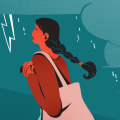Mental health conditions now cause 1 in 5 years to live with disabilities. About 20% of the world's children and adolescents have a mental health condition, with. Mostly due to demographic changes, there has been a 13% increase in mental health conditions and substance use disorders over the past decade (up to 201.About 20% of the world's children and adolescents have a mental health condition, and suicide is the second leading cause of death among young people from 15 to 29 years old). About one in five people in post-conflict situations have a mental health condition.
WHO psychological intervention is effective in preventing mental disorders among Syrian refugees in Turkey New storybook to help children maintain hope during COVID-19 The world faces a series of unprecedented emergencies. In reaction to these complex adversities, many people experience considerable distress. Ensuring a coordinated and effective mental health response in emergencies. It is not uncommon for a person with an anxiety disorder to also suffer from depression or vice versa.
Almost half of people diagnosed with depression are also diagnosed with anxiety disorder. Generalized anxiety disorder (GAD) GAD affects 6.8 million adults, or 3.1% of the US. Population, but only 43.2% receive treatment. Women are twice as likely to be affected as men.
GAD often occurs along with major depression. Panic disorder (PD) PD affects 6 million adults, or 2.7% of the US. Specific phobias Specific phobias affect 19 million adults, or 8.7% of the US. UU.
Symptoms usually begin in childhood; the average age of onset is 7 years. Obsessive compulsive disorder (OCD) and post-traumatic stress disorder (PTSD) are closely linked to anxiety disorders, which some may experience at the same time, along with depression. Related Diseases Many people with an anxiety disorder also have a co-occurring disorder or physical illness, which can worsen their symptoms and make it difficult to recover. Treatment for both disorders is essential.
Anxiety disorders affect 25.1% of children between 13 and 18 years old. Research shows that children with anxiety disorders who do not receive treatment have a higher risk of performing poorly in school, missing important social experiences, and engaging in substance abuse. Older adults Anxiety is as common among older adults as it is among young people. Generalized anxiety disorder (GAD) is the most common anxiety disorder among older adults, although anxiety disorders in this population are often associated with traumatic events such as a fall or acute illness.
Read the best way to treat anxiety disorders in older adults. Depression is the leading cause of disability worldwide. Almost 75 per cent of people with mental disorders are not treated in developing countries and nearly 1 million people take their own lives each year. In addition, according to the World Health Organization (WHO), 1 in 13 suffer from anxiety worldwide.
WHO reports that anxiety disorders are the most common mental disorders worldwide, with specific phobia, major depressive disorder and social phobia being the most common anxiety disorders. The ADAA is not a direct service organization. The ADAA does not provide psychiatric, psychological or medical advice, diagnosis or treatment. Founded in 1979, ADAA is an international non-profit organization dedicated to the prevention, treatment and cure of anxiety, depression, OCD, PTSD and co-occurring disorders by aligning research, practice and education.
Transforming the understanding and treatment of mental illness. NIMH offers peer-reviewed information on mental disorders and a variety of topics. The NIMH statistics pages include statistics on the prevalence, treatment and costs of mental illness for the population of the United States. Download, read and order free NIMH brochures and fact sheets on mental disorders and related topics.
If you or someone you know has a mental illness, there are ways to get help. Use these resources to find help for yourself, a friend or family member. If you or a friend or family member are thinking about participating in clinical research, this page contains basic information about clinical trials. Learn how NIMH engages a variety of stakeholder organizations as part of its efforts to ensure the greatest public health impact of the research we support.
Use these free mental health education and outreach materials in your community and on social media to disseminate topics such as eating disorders, autism awareness, and suicide prevention. Get Involved Calendar of Celebrations NIMH supports research in universities, medical centers and other institutions through grants, contracts and cooperation agreements. Learn more about NIMH research areas, policies, resources and initiatives. The Intramural Research Programmes Division (IRP) is the internal research division of NIMH.
More than 40 research groups conduct basic neuroscientific research and clinical investigations of mental illness, brain function and behavior at the NIH campus in Bethesda, Maryland. Learn more about research conducted at NIMH. Find all funding opportunities from NIMH and among NIH. Learn more about the NIMH Strategic Research Plan, strategic research priorities, the anatomy of NIMH funding and our annual funding strategy for research grants.
Explore the NIMH grant application process, including how to write your grant, how to submit it, and how the review process works. Learn how NIMH manages research grants, including policies and requirements. Find the latest NIH and NIMH policies, guidance and resources for clinical research. Explore NIMH research and professional development training opportunities.
Learn about funding opportunities for small businesses. Supporting Clinical Trials at NIMH List of NIMH Science News, including press releases, scientific updates and announcements from the institute. Stories of research conducted by researchers from institutions supported by NIMH throughout the country and researchers from the Division of Intramural Research Programmes (IRP) of NIMH. Details on upcoming events, including meetings, conferences, workshops, conferences, webinars and NIMH-sponsored chats.
NIMH videos and podcasts with science news, conference series, meetings, seminars and special events. Follow NIMH on social media Twitter, Facebook, YouTube and LinkedIn. Information about NIMH, research outputs, summaries of scientific meetings and mental health resources. NIMH organizes a series of annual conferences dedicated to innovation, invention and scientific discovery.
Learn more about NIMH director Joshua A. Read about the boards and groups that advise and provide guidance to the Institute. The NIMH Strategic Research Plan is a comprehensive roadmap for the Institute's research priorities over the next five years. Learn more about NIMH's commitment to accelerating the pace of scientific progress and transforming mental health care.
Learn more about the roles of each NIMH office and division. Read the annual justifications of the NIMH Congress. Search jobs, including scientific, administrative and executive careers at NIMH. Find the names, phone numbers, email addresses and office locations of NIMH staff.
Find directions, maps, parking information and other visitor information for NIMH. Contribute to mental health research The wide variety of anxiety disorders differ according to the objects or situations that induce them, but share characteristics of excessive anxiety and related behavioral disorders. Anxiety disorders can interfere with daily activities, such as work performance, school work, and relationships. For the data presented on this page, any anxiety disorder included panic disorder, generalized anxiety disorder, agoraphobia, specific phobia, social anxiety disorder (social phobia), post-traumatic stress disorder, obsessive compulsive disorder, and separation anxiety disorder.
Additional information about anxiety disorders can be found on the NIMH Health Topics page on Anxiety Disorders. The National Institute of Mental Health (NIMH) is part of the National Institutes of Health (NIH), a component of the U.S. Department of Health and Human Services. Know the Common Signs of Mental Illness in Adults and Teens.
Learn more about common mental health conditions affecting millions. Or in a crisis, text NAMI to 741741 Million people in the US. They are affected by mental illness every year. It is important to measure how common mental illness is, so that we can understand its physical, social and financial impact so that we can prove that no one is alone.
These numbers are also powerful tools for raising public awareness, combating stigma, and advocating for better health care. The information in these infographics and on this page comes from studies conducted by organizations such as the Administration for Mental Health and Substance Abuse Services (SAMHSA), the Centers for Disease Control and Prevention (CDC), and the U.S. The terminology used reflects what is used in the original studies. Terms such as “severe mental illness”, mental illness or “mental health disorders” may seem to refer to the same thing, but in fact refer to specific diagnostic groups for that particular study.
If you or someone you know is in an emergency, call The National Suicide Prevention Lifeline at 800-273-TALK (825) or call 911 right away. NAMI 4301 Wilson Blvd. Anxiety disorders refer to a group of mental disorders characterized by feelings of anxiety and fear, including generalized anxiety disorder (GAD), panic disorder, phobias, social anxiety disorder, obsessive compulsive disorder (OCD), and post-traumatic stress disorder (PTSD). Find more COVID-19 testing locations in Maryland, gov.
An estimated 26% of Americans aged 18 and older, about 1 in 4 adults, suffer from a diagnosable mental disorder in any given year. Many people suffer from more than one mental disorder at any given time. In particular, depressive illnesses tend to coexist with substance abuse and anxiety disorders. Approximately 9.5% of U.S.
adults age 18 and older will suffer a depressive illness (major depression, bipolar disorder, or dysthymia) each year. Most people who commit suicide have a diagnosable mental disorder, most commonly a depressive disorder or substance use disorder. Approximately 1% of Americans are affected by schizophrenia. There are different ways to estimate which children are struggling with mental health.
CDC uses surveys, such as the National Child Health Survey, to understand which children have diagnosed mental disorders and whether they received treatment. In this type of survey, parents report on the diagnoses their child has received from a health care provider. Learn more about children's mental disorders below. Early diagnosis and appropriate services for children and their families can make a difference in the lives of children with mental disorders, 7 Access to providers who can offer services, including screening, referrals and treatment, varies by location.
CDC is working to learn more about access to behavioral health services and supports for children and their families. View information by state describing rates for different types of providers that may offer behavioral health providers by county. Read a recent report describing the shortage of services, barriers to treatment, and how integrating behavioral health care with pediatric primary care could address issues, external icon Read a policy brief on possible ways to increase access to mental health services for children in rural areas is it and why is it important? There are many different datasets that include information about children's mental health and related conditions for children living in the United States. National Health and Nutrition Examination Survey (NHANES) The NHANES assesses health and nutrition status through interviews and physical examinations, and includes conditions, symptoms and concerns associated with mental health and substance abuse, as well as the use and need for mental health services.
National Health Interview Survey (NHIS) The NHIS collects data on children's mental health, mental disorders such as ADHD, autism spectrum disorder, depression and anxiety issues, and the use and need of mental health services. National Survey on Drug Use and Health (NSDUH), external icon The NSDUH, administered by the Administration for Mental Health and Substance Abuse Services (SAMHSA), provides national and statewide data on tobacco, alcohol and illicit drug use (including non-medical use of prescription drugs), as well as mental health data in the United States. School-Associated Violent Death (SAVD) Study SAVD plays an important role in monitoring trends related to school-associated violent deaths (including suicide), identifying factors that increase risk, and evaluate the effects of prevention efforts. Study of School Health Policies and Programs (SHPPS) SHPPS is a national survey that evaluates school health policies and practices at the state, district, school and classroom levels.
Data collected includes mental health and social services policies. Web-based Injury Statistics Reporting and Query System (WISQARS) WISQARS is an interactive database system that provides personalized reporting of injury-related data. Youth Risk Behavior Surveillance System (YRBSS) The YRBSS monitors health-risk behaviors, including tobacco use, substance abuse, unintentional injury and violence, sexual behaviors that contribute to unwanted pregnancy, and. .


